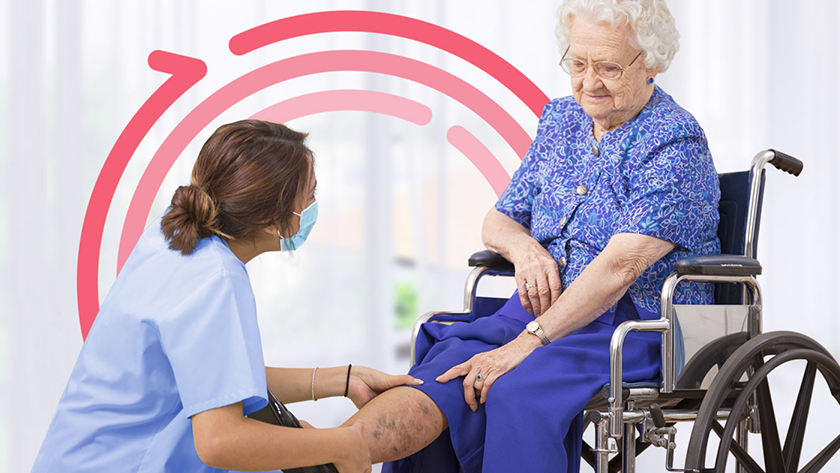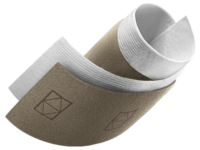Venous stasis ulcers: Explore the best treatments to promote healing
Manage chronic venous insufficiency, from compression to nutrition.

About 2.5 million people in the U.S. suffer from chronic venous insufficiency, a form of venous disease.¹ These are your patients who are at risk for venous leg ulcers, which can be painful and hard to heal. That’s why it’s important to understand and share with your team the right tools and strategies to prevent and treat these chronic wounds.
Caring for patients with venous stasis ulcers comes down to 3 essential steps:
1. Control
2. Treat
3. Engage
1 | Control the swelling caused by venous stasis
“When we talk about the one thing we need for a wound to heal, it’s good circulation,” notes Suzie Ehmann, DPT, CWS, CLT-LANA, Clinical Specialist at the Edema Management Center at Carolinas Healthcare System Stanly in Albemarle, North Carolina, and a Medline consultant.
But that’s just the problem with venous leg ulcers: poor circulation. Damaged blood valves cause blood to flow the wrong way, building up pressure in veins of the leg, which can cause blood vessels to burst, damage the skin and lead to those chronic stasis ulcers. One solution: the right compression.
“At the root, compression enhances circulation—lymphatic, venous and arterial flow,” Ehmann says.
Ehmann likes to use the analogy of water to help both staff and patients visualize the medical condition: When water is left sitting, as in a pond, it builds up a film. To keep the water clean and clear, it needs to keep moving, like in a fountain. “Compression maintains constant circulation of new blood in, and the old stuff out,” she says.

2 | Treat venous leg ulcers
When it comes to helping venous leg ulcers heal, remember these steps:
- Remove the wound exudate. When necrotic tissue and other wound debris is present, debridement is essential to start the healing process. Debridement can be achieved several ways, and a concentrated surfactant-based gel such as PluroGel supports autolytic debridement.
- Apply an appropriate dressing. One of the most advanced wound dressings available includes chitosan, a well-known biological material derived from crustacean shells. It works by creating a strong, absorbent and conformable gel that manages drainage and removes exudate from the wound.
- Care for the fragile skin. Patients with venous stasis may complain of dry, itchy skin around their VLU and under their compression garments. A botanical-rich, pH-balanced skin care system helps condition dry skin.
Reduce biofilm to encourage wound healing
There’s a growing understanding that the presence of biofilm hinders the healing of VLUs and other chronic wounds.
A quick refresher on biofilm: biofilm is composed of bacterial structures that physically attach to a surface. They’re highly tolerant to antibiotics and biocides because of a protective layer called the extracellular polymeric matrix.
Fight biofilm in chronic wounds with advanced wound care:
- Soften, loosen and trap debris to help disrupt biofilm. The hydrophobic and hydrophilic action of PluroGel also promotes a moist healing environment.2
- Create a cleaner wound bed with a foam dressing that works hard. In IoPlex Iodophor Foam Dressing, iodine is released in a controlled way for regulated and sustained infection management, without the cytotoxicity.
Based on in vitro testing, PluroGel and IoPlex are effective strategies for managing biofilm.
3 | Engage patients in their care
Successful compression therapy depends on choosing the right product. It also depends on the patient adhering to treatment. “What’s the key to compliance? Education,” Ehmann concludes.
One of Ehmann’s main strategies for patient compliance is to get patients on board every step of the way. “Sometimes we might have the attitude of, ‘I’m the specialist, and you just need to do what I say,’ and we don’t explain why. This is a disservice to our patients.”
Ehmann’s patient compliance tips:
- Educate patients on why there’s swelling and even how their wound developed. Draw pictures and have them describe it back to you.
- Don’t assume patients already understand everything about their venous leg ulcer. They probably don’t.
- Feel free to repeat yourself. Every visit is an opportunity to reinforce their education and engagement.
“In general, we need to get patients out of the passive role and into a participatory role.”
Also remember that applying a compression device can be complicated, leading some patients to just give up. Help your patients stick to wearing compression by looking for compression garments with educational packaging and that are easy to put on and remove.

“In general, we need to get patients out of the passive role and into a participatory role.”
— Suzie Ehmann, DPT, CWS, CLT-LANA, Clinical Specialist at the Edema Management Center at Carolinas Healthcare System Stanly and Medline consultant
Proper nutrition can help ulcers heal
Be sure to consider your patients’ protein intake along with other comorbidities. Studies show that malnutrition may be a hidden danger associated with poor wound healing.3 Read more about how a comprehensive nutrition program can help improve wound healing outcomes.
Key takeaway
Venous leg ulcers can be painful and hard to heal. One of the first steps to managing the underlying venous stasis disease is through compression. Engage patients in compression therapy plans to help you improve compliance. When it comes to treating venous ulcers, remove wound debris, apply advanced wound dressings, care for at-risk skin and consider comorbidities such as malnutrition. Share these tools and strategies with frontline staff to help make skin health second nature.
Discover more ways to help manage chronic venous insufficiency:
Request an assessment to help standardize care and reduce skin breakdown.
Earn continuing education credits with an online class.
Know how to distinguish between three common lower extremity wounds. Download the educational posters now.
Watch the webinar to learn more about chronic wounds and biofilm.
References:
- Eberhardt, R. T., & Raffetto, J. D. (2014). Chronic Venous Insufficiency. Circulation, 130(4), 333–346. Available at https://doi.org/10.1161/circulationaha.113.006898
- Yang Q, Larcose C, Porta AD, Della Porta AC, Schultz GS, Gibson DJ. A surfactant-based wound dressing can reduce bacterial biofilms in a porcine skin explant model. International Wound Journal. 2017;14(2):408-413
- https://www.ncbi.nlm.nih.gov/pmc/articles/PMC4144253/
